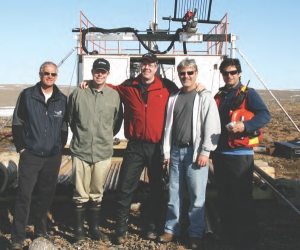Peregrine Diamonds’ (PGD-T, PGDIF-O) stock surged 108% or 96¢ a share to close at $1.85 with 8.2 million shares trading hands on news that it had recovered large diamonds from drill core at the CH-6 kimberlite at its Chidliak project on southern Baffin Island, in Nunavut.
Calling the microdiamond results “spectacular,” newsletter writer John Kaiser advised readers of the Sept. 21 edition of his Daily Bottom-Fish Report that Peregrine “should be held as a core diamond position in anticipation that Chidliak will prove to be a world-class diamond field, confirmation of which would translate into a $10-20 price range for Peregrine.”
The latest results “add to a growing body of evidence that the Chidliak kimberlite field is shaping up to be the most important diamond discovery in Canada since Dia Met discovered Ekati in late 1991,” he wrote.
Peregrine reported that a 398.8-kg sample collected from CH-6 yielded 2,730 diamonds larger than the 0.075-mm sieve size, including 131 diamonds larger than the 0.6-mm sieve size.
Holes CH-6A and CH-6B together produced 62 diamonds greater than a 0.85-mm sieve size weighing 2.5 carats (from a 398.8-kg sample between the two holes) for a diamond content of 630 carats per hundred tonnes.
The CH6-A sample (weighing 199.8 kg) yielded 49 diamonds greater than the 0.85-mm sieve size weighing 2.09 carats, with the largest diamond a 0.62-carat white transparent aggregate for a diamond content of 1,050 carats per hundred tonnes.
The CH6-B sample (199 kg) produced 13 diamonds greater than the 0.85-mm sieve size weighing 0.41 carat with the largest diamond a 0.15-carat white transparent fragment for a diamond content of 210 carats per hundred tonnes.
Thirty of the 62 diamonds larger than the 0.85-mm sieve size from CH-6 were classified as having a white colour, 18 were described as off-white, 10 were yellow and four were grey or brown.
Kaiser urged investors to buy Peregrine at below $2 per share and hold the stock for additional microdiamond results and the CH-1 mini-bulk sample that are expected in the last quarter of 2009.
In a telephone interview, Eric Friedland, Peregrine’s chief executive, and Brooke Clements, the company’s president, said the microdiamond results were some of the best results in the history of Canadian diamond exploration.
“These are some of the best microdiamond results since the discovery of Diavik and what this industry has been looking for since the discoveries of Ekati and Diavik,” Friedland says. “These pipes, CH-1 and CH-6, so far appear to have serious grade potential.”
Clements notes that the results from CH-6 were some of the strongest he had seen in his 27- year career in diamond exploration and added that it took Ekati about 24 months of drilling before it had all the pipes that went into its mine plan, whereas Peregrine has already had tremendous success in just nine weeks of drilling.
“So far we’ve drilled 14 anomalies and discovered kimberlites in seven of them.”
Friedland added that some of the anomalies they will be drilling starting in April or May of next year have geophysical signatures and associated kimberlitic indicator mineral trains that “are even better looking” than many of the ones they’ve analysed so far.
“We’ve demonstrated that Canada is still a fantastic place to explore for diamonds,” he said. “It’s great for Canada, it’s great for the diamond industry.”
Over the next few months, Peregrine will be receiving diamond results from 11 more kimberlites discovered this year and from the 50-tonne sample collected from CH-1.
Peregrine reported its discovery of CH-6 in August and released additional drill information on Sept. 14. The CH-6A sample was described as consisting of uniform primary volcaniclastic kimberlite with 5-15% country rock xenoliths including carbonate rocks, abundant mantle xenoliths and 40-50% olivine macrocrysts up to 9 mm in size.
The CH-6B sample was characterized as being texturally variable volcaniclastic kimberlite with layering and varying concentrations of mantle xenoliths and olivine macrocrysts. Magmatic kimberlite was also present at CH-6 and Peregrine has submitted a 200-kg sample collected from drill-hole No. 5 for caustic fusion analysis.
(Volcaniclastic kimberlite can contain fragments of kimberlitic material and other rock types and forms as a result of near-surface explosive volcanic activity. Magmatic kimberlite represents the original kimberlite magma that has not been exposed to explosive volcanic activity.)
In addition to the CH-6 results, Peregrine reported that the CH-5 kimberlite is also diamondiferous with a 423.7-kg surface sample yielding 49 diamonds larger than the 0.075-mm sieve size.
Peregrine discovered the CH-5 kimberlite at surface on July 16.
The CH-5A sample was collected from surface volcaniclastic kimberlite material that is described as having less than 5% country rock xenoliths, including limestone and minor amounts of olivine macrocrysts and other indicator minerals. The CH-5B surface sample is described as fine-grained magmatic kimberlite with no visible country rock xenoliths and minor olivine macrocrysts.
In light of the results from CH-6, a sample of roughly 100 kg of CH- 10 is being submitted for micro-diamond analysis. (The discovery of the CH-10 kimberlite was reported on Sept. 14.) CH-10 was discovered by drilling one of four magnetic low anomalies aligned for about 600 metres like a “string of pearls” in a north-northwest direction from the CH-6 kimberlite pipe.
The CH-10 kimberlite is described as magmatic with 40-50% olivine macrocrysts up to 10 mm in size, and abundant mantle-derived garnets.
Further work, including detailed ground geophysics and drilling to investigate the overall kimberlite tonnage potential of the CH-6 pipe and the associated “string of pearls” system is planned for next year.
Peregrine is the operator of the exploration program on the 9,800-sq.-km Chidliak project, which is being fully funded by BHP Billiton (BHP-N, BLT-L).
Last November, BHP Billiton exercised its earn-in rights and will spend $22.3 million in exploration for a 51% interest in the property.


Be the first to comment on "Peregrine Shares Rocket On Latest Diamond Results At Chidliak"